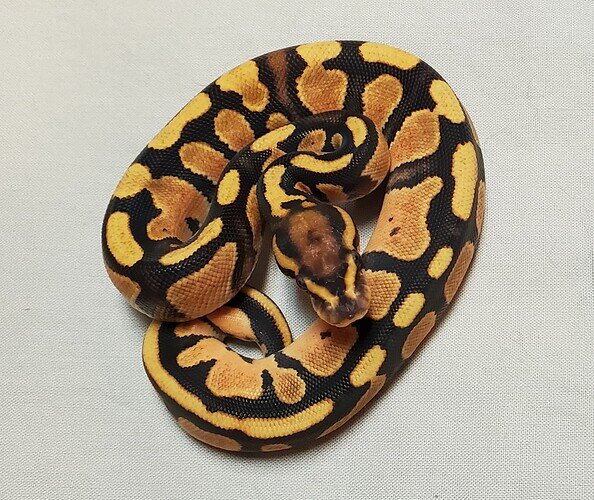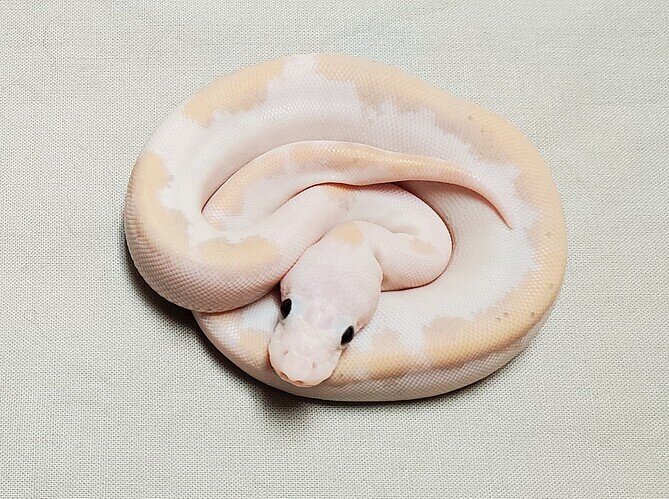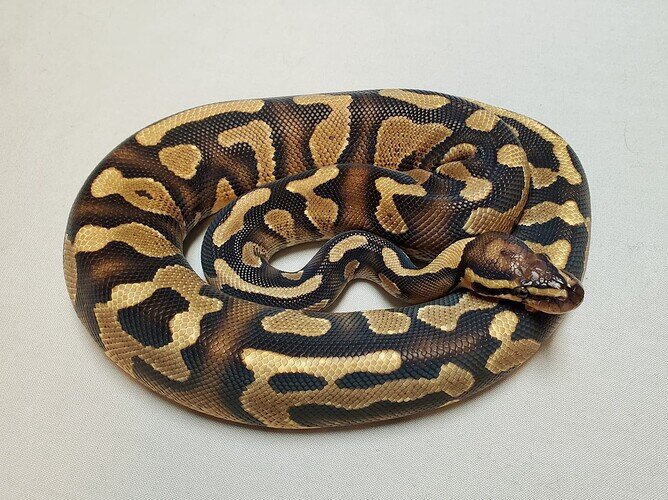It may not hurt to check the genders of the second clutch but the presence of a male in the first clutch at least eliminates the possibility I was thinking of for that clutch
TH,
Of the four survivors in the second clutch, there are 3 males and 1 female. Looking at the level of jaw deformities and their locomotion, which is really strange, I will be culling 3 of them for sure. The 1 remaining of the 8, I will be observing for a while before making a decision. At a glance, it appears to be fairly normal in appearance and motion.
I have a bit of input here….
I bought a proven breeder female, my girl Ava. A pastel het VPI axanthic. Her clutches from before have been fine, as I saw some of her babies also listed by the same breeder
I also had a male, a banana yellowbelly that I had bought and raised myself. Last year, I paired him to 2 females… Ava, and my spider female Gwen.
Ava’s clutch was a disaster. 8 perfect eggs, 3-4 died during incubation, and of the remaining eggs… 1 baby was tiny and severely kinked. It never made it out of the egg.
One died in the egg of unknown reasons. Had a minor tail kink.
Yet another I had to cull because it’s belly had ruptured.
The last one also has a minor tail kink, but he was the only one who survived. I had to assist feed him for months and months, but he’s now eating on his own and is now a little over 300 grams. He will always be a pet only.
Now, the other clutch? 10 perfect eggs, hatched out 10 perfect babies.
One passed away after hatching but had been eating. Unsure what happened but likely was out of my control.
Now, I still don’t quite know why the first clutch was such a mess. I hatched out 4 clutches that year and the other 3 were just fine. Could have been an incubation issue, could have even been related to the fact that Ava held onto her eggs for almost 50-60 days before laying them… who knows.
How many people besides me had to look this up?
Occam’s Razor is what you use to cut snake eggs 
I was just confused by the term
Occam’s Razor is a term that has been coined after a philosopher named William of Ockham. Simply put, it states that if there are two or more competing theories, the simplest of the theories tends to be the most likely. It is not always so, but it tends to be accurate more times then not. It is based on making fewer assumptions using the most information.
In the instance I am using it, it seems a stretch to think that everything had to go wrong environmentally for two clutches, independent of the other three in the same environment, when the two clutches had a common denominator of the same male siring each.
Maybe apply Hanlon’s Razor to this breeder you got the male from?
Perhaps. I like where you’re going.
So I just wanted to follow up on this and close it out. I have once again bred the Sire in question to a known proven female, that has produced nothing but beautiful babies in the past. The results were similar to the others in that, of 5 eggs, 3 required culling and two appear to be normal. What I am calling normal is normal in proportions, no visible deformities, and their locomotion appears typical. There is however, a new development that I can’t account for other than presuming there is another gene present that wasn’t advertised or supposed to be there. One of the survivors, as well as one of the culled animals, appear to be or have been Super Fires. When I look back at the lone survivor of the clutch that the Ivory female laid, I now believe it is actually YB Fire. I always felt it looked off for just being YB double het.
This last time, I incubated the single clutch by itself, with proven methodology I have used before. Temps were very stable at 87 F and there was never even a degree of variation. So my findings are such that this animal will never be bred again. I have arranged to rehome the Sire with a relative that has told me he will never breed him and if he ever is to get rid of the animal, it is to come back to me. All of the surviving offspring from the three clutches, will likely be rehomed as pets only, unless I first try to breed them myself and see what the results are. Personally, I am not very inclined to do so as it could result in me having to cull more animals. Anyways, here are pictures of the two from this clutch, and this will close this chapter and thread. Thanks for coming along.
I appreciate the update on this clutch. I was reading through and while I agree that many things other than genetics can cause severe genetic defects, I also do see a common denominator here. Especially given that you’ve now used three different females and two separate years of incubation to rule out a one-time weird spike. I think it’s a good idea to retire the male as a breeder.
I’m assuming the female you bred this most recent time had fire, and you are assuming the male must also have fire. I would double check the sex on the living super fire, as if it’s female, it could potentially indicate parthenogenesis. But after three clutches, regardless of partho, I would retire the male as well.
I agree with @erie-herps that euthanizing healthy animals is unethical, so I think the best option would be to find them pet only homes, which is what it sounds like you intend to do, and I applaud you for that.
Pet only homes are great! Ours is a willing, pet-only home!
I apologize but I am not sure how to address you Inspiration. Yes, the female did carry the fire gene and I now believe the sire does as well. Besides the alleged Super Fire, one of the other clutches produced the boy pictured below. He should have only been a YB double het, sired by the same male paired with an Ivory. I now believe he is Fire YB dbl het. I did have him for sale originally hoping this breeding would prove me wrong. However, since I feel I confirmed my original suspicions, I pulled him off the market.
Like I said, the first two clutches produced a male each that appear normal and are nearing breeding size. I may try pairing them with known proven females and if the results are normal, then I will sell them as regular animals. I will still inform the Buyer about the history for transparency sake, but then it will be their decision. I have not euthanized anything that I felt could live a relatively normal life, but most of the deformities were far too severe.
SB
I will keep that in mind.
I was also skeptical of the male being the cause of the first two clutches but the third certainly makes it seem more likely.
Out of curiosity, did the first two females go on to produce good clutches for you after the bad clutches?
I was wondering if the common factor could be a disease rather than genetics? I remember my vet saying something about STDs in snakes years ago. I thought he said something about one that was self limiting in one gender but not the other.
I once owned a very large female ball python that produced missing eye deformity babies more than once with different males. At first I assumed it must be her genetics but my ultimate theory was that her clutches (up to 14 eggs) were too large for my incubation tubs and perhaps were overheating.
I actually haven’t had the opportunity to breed either of the first two females again. However, the coupling this year was with a proven female that had no issues until the clutch with the suspect male. I hope to breed at least one of the two original females this season with a different male. We’ll see what comes of it.


